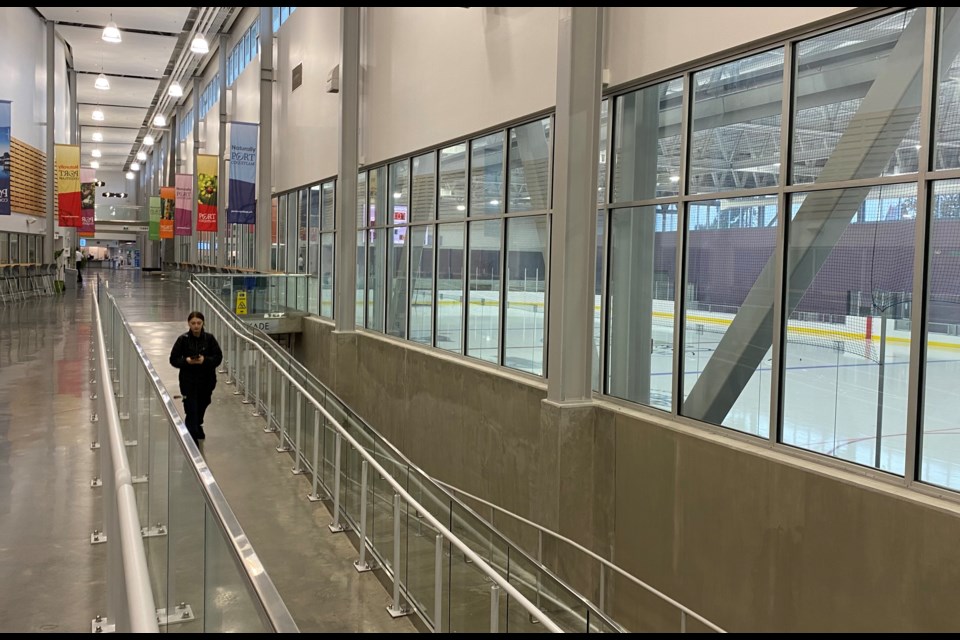Port Coquitlam has achieved a rare gold ranking for making its new community centre accessible for people of all ages and abilities.
From the minute the sensor-controlled power doors open for entry, it's easy to see why the Port Coquitlam Community Centre has earned the distinction, according to a disability expert and advocate with the Rick Hansen Foundation.
For visitors grabbing coffee or lunch, watching their kids play hockey, attending a fitness program or swimming, the brightly lit, spacious building provides a welcoming experience.
"Port Coquitlam said, 'We want to set the bar high.' It took them five years to get this done," said Brad McCannell, vice president, access and inclusion for the Rick Hansen Foundation.
Only about six per cent of Canadian buildings have achieved the gold standard, said McCannell, and he congratulated PoCo for creating a barrier-free facility.
"It means more people are included. It means the facilities you have are serving more people in more ways."
Welcoming people with hearing, vision loss
For PoCo making the new rec centre barrier-free started with hiring a disability consultant during design — something McCannell said more builders and architects should do to avoid costly additions later.
Among the useful additions at the facility located at 2150 Wilson Ave. is an adult change table big enough to accommodate someone six feet tall, weighing 300 pounds.
Located in the aquatics area, the table makes it easier for someone in a wheelchair to get dressed for a swim.
"Otherwise they get changed on the floor," said McCannell.
"By having just that one feature, if you didn’t have anything else, you have opened it up to many more people."
Some accessibility features are obvious:
- Elevators between floors
- Contrasting paint on safety strips on stair nosings
- Universal washrooms that are spacious with sinks and toilets at optimum heights
- Braille signage
- Wheelchair ramps
- Railings for way-finding for people using touch to get around
- Doors that open automatically
Innovations don't have to cost a lot and can be simple to use but make a big difference, he said.
For example, there's a hearing loop at the reception desk that automatically engages when someone is wearing a hearing aid.
"A person walks up and are treated normally like everyone else," said McCannell.
Fire alarms have visual cues — flashing lights — to let people who are hard of hearing know if there's a fire.
People won't go if they are afraid or will 'feel stupid'
Too often, said McCannell, people won't go to a community centre because they are afraid or don't want to "feel stupid."
McCannell credited Port Coquitlam with taking leadership, and said the city could have backed out at "anytime" and settled for accessibility certification but pushed ahead to add features that make the community centre easier to use for people.
Now the challenge is to get more architects and builders to understand the need for accommodating people with disabilities into their building and design, and not just those using a wheelchair.
Only 40 per cent of Canadian buildings meet the foundation's basic standards even though it's inexpensive — about one per cent — to design and build a barrier-free facility.
Meanwhile, 50 per cent of the Canadian population lives with a disability — either temporary or permanent — or lives with someone who has a disability, according to the foundation.
McCannell advocates for building code changes and national standards and encourages architects and builders to take professional training with the Rick Hansen Foundation.
"People are aging — you'll have to put it in eventually so you can pay me now or pay me later," said McCannell.
"It’s not hard to get it right."
Who is Rick Hansen - Man in Motion
Tri-City residents may remember Rick Hansen and his Man in Motion World Tour of 34 countries in 1985.
In 2012, Rick Hansen re-did his tour, including pushing his wheelchair up Thermal Drive from Port Moody to Coquitlam, a steep incline. He was accompanied by a large group of well-wishers and supporters.





